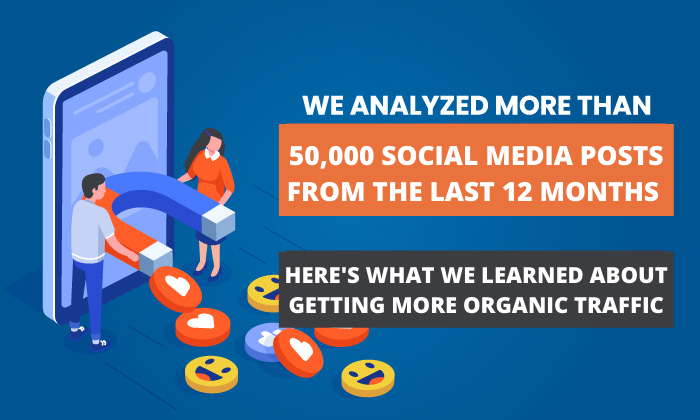
Facebook, Instagram, LinkedIn, Pinterest and every other social network you can think of eventually does the same thing.
Can you guess what it is?
They adjust their algorithms to cram down reach and sharing. That means you won’t get as much traffic from them unless you start advertising.
But even with their algorithm changes, there must be a way to maximize the traffic you can get from each social network, right?
In order to find out, we analyzed over 50,000 social media posts sharing content in 10 different industries.
The posts analyzed were some of the most shared on Facebook, Twitter, and Pinterest from the last 12 months and contained a link to industry-related content. We couldn’t get access to enough data from other social media channels.
What Industries Did We Look At?
Although there are tons of different industries out there, we focused on the following 10 that contained the majority of posts and social media engagement. This allowed us to share better insights on what can be done to get more organic social traffic.
Here are the 10 industries we looked at:
- Business
- E-commerce
- Fashion
- Food
- Health
- News
- Politics
- Sports
- Technology
- Travel
Analysis #1: Social Media Engagement For Each Industry Over the Last 12 Months
The first graph below shows the total social media engagement for content related to each industry over the last 12 months. This is the grand total and not a monthly average.
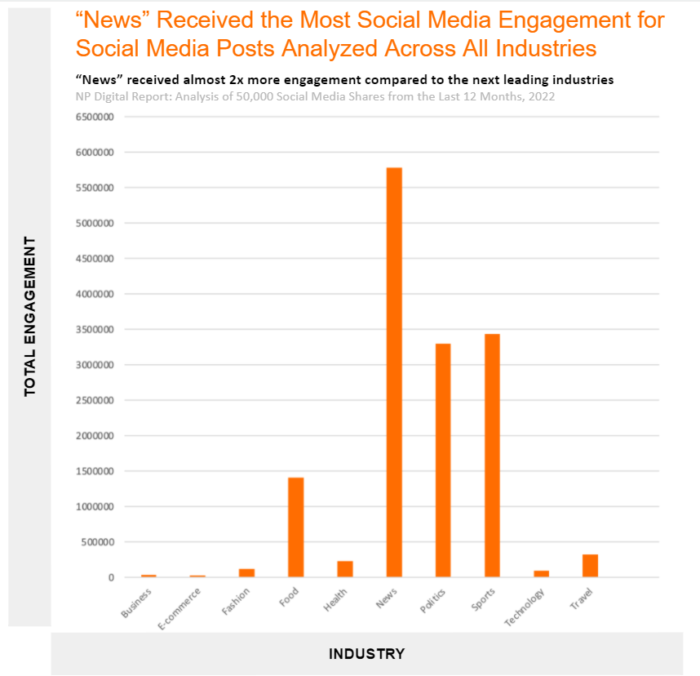
The key highlight is that News-related posts had the most engagement followed by Sports and then Politics.
It’s worth noting that social media posts related to Business and E-commerce received virtually no engagement which might highlight some trends for both industries.
To make sure the data wasn’t biased or skewed, we also looked at the average engagement data for each post versus just the total.
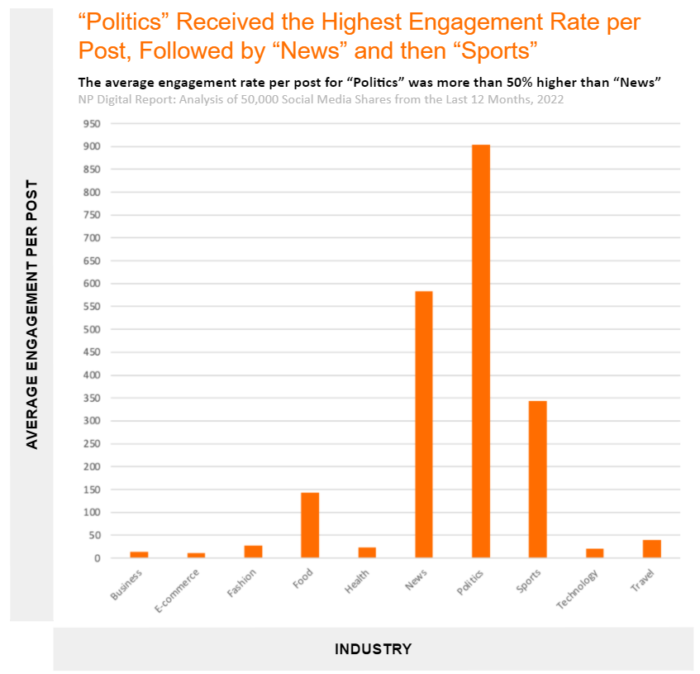
The results were similar for the majority of industries, but with one key difference. Even though News received the most total social media engagement, it was behind Politics when looking at the average engagement per post.
But as everyone knows, don’t talk about politics at the dinner table. In other words, you don’t want to polarize your audience.
Regardless of which industry you belong to, incorporating news-related subjects in your content could be a great way to get more engagement and traffic.
For example, if you own a music-related website, you may try to break news or write about it on your blog such as when Apple bought a company called Beats by Dre years ago. If the acquisition took place today, Apple would want to make sure their blog covered the move and then share it across their social media channels for added engagement.
Alternatively, if you were a business-related website, you could discuss the Beats by Dre acquisition from your perspective. Even if you aren’t the first company talking about it, you can discuss why they made the move and share your top 5 predictions for what will happen over the next 5 years.
On another note, let’s say you own a travel-related website. You could talk about restrictions each country has with quarantining and how it gets adjusted on a monthly or even weekly basis.
Regardless of what industry you are in, there are always opportunities to tie in the news which can lead to more social engagement, resulting in more organic traffic to your website.
Analysis #2: What Type of Content Works Best on Social Media Networks?
For fun, we also looked at which industries performed the best on each social network in terms of shares.
Here are the average Facebook shares for content related to each industry:
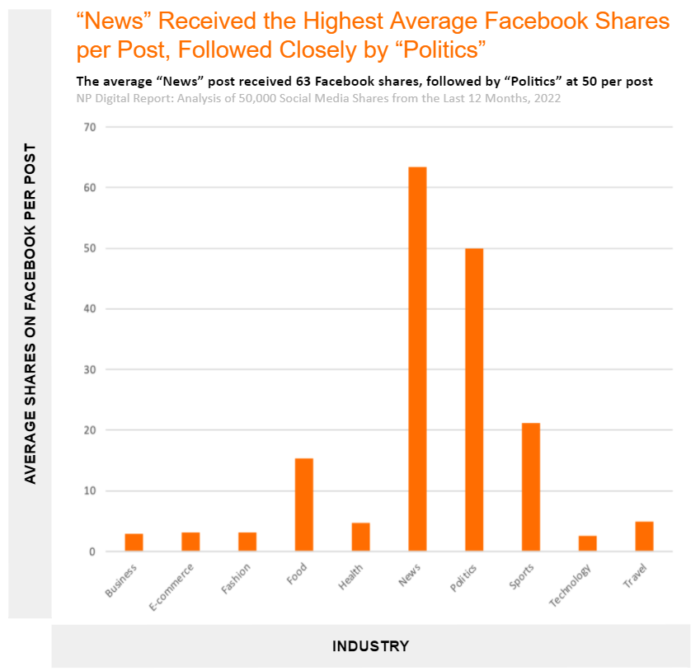
And here is what the data looks like for Twitter.
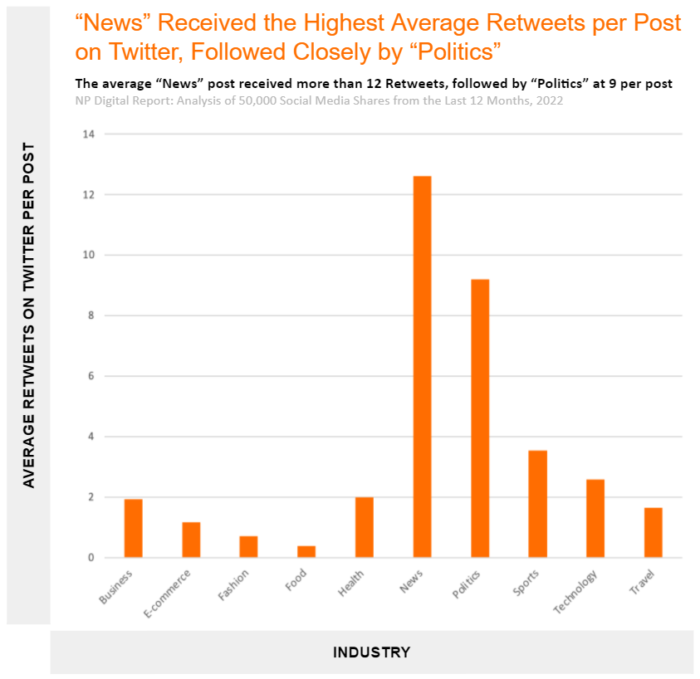
And Pinterest…
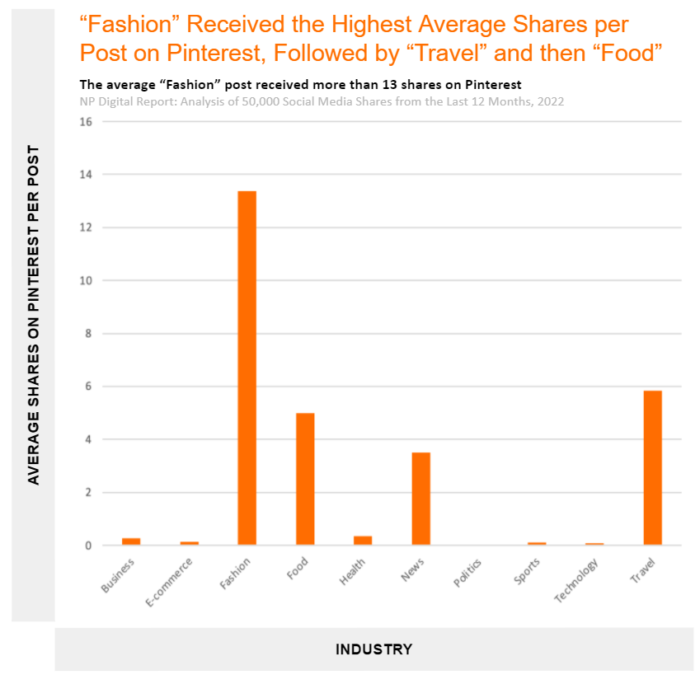
No shocker, but Facebook and Twitter prefer News-related content. Pinterest, on the other hand, prefers content that is more visual so industries such as Fashion, Travel, and even Food performed better.
As I mentioned before, if you want to get more traffic from Facebook and Twitter, find ways to tie in News-related topics or events to your content. Even if you aren’t a part of the industry it can help you get traction.
But if you want more traffic from Pinterest, focus on anything that is visual.
Now, none of that is really eye-opening. So we decided to dig a bit deeper to see the types of content that were most popular on these platforms.
I would assume infographics would perform best as they are easily shareable and are easy to generate links to.
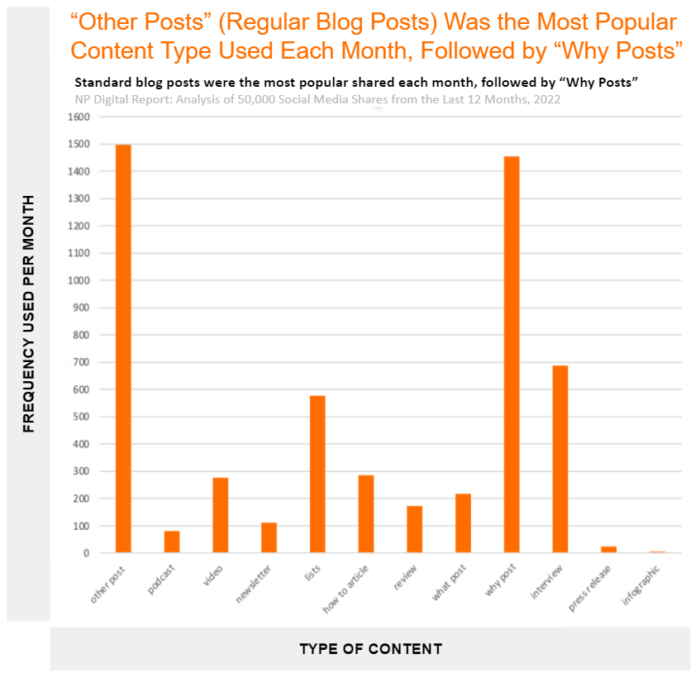
Funnily enough, infographics had the worst performance from a social standpoint.
On the flip side, I would never have guessed that “why” posts and “interview” based posts would do so well.
List-based content is pretty much a given as everyone loves lists such as “The 7 benefits of green tea”.
As for the appeal of why-based posts, think of topics like “why isn’t there an eclipse every month” or “why don’t people wear white after labor day”.
For interviews, people want to hear from people who intrigue them. For example, if you were to be able to get an interview with business leaders like Elon Musk or Jeff Bezos, athletes like Lebron James or Cristiano Ronaldo, or even political figures who are trending at the time, you can bet it will get a lot of social shares.
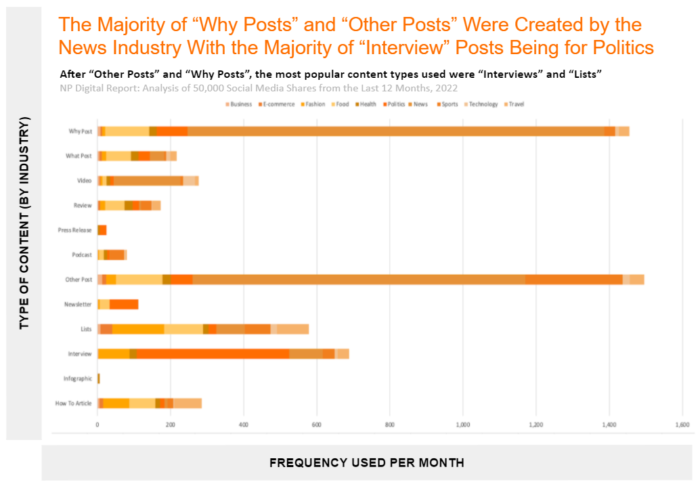
In case you were curious about which content type was leveraged most by each industry, the graph above shows that. You can see how the News industry releases a lot of why-related content but industries like Business or E-commerce don’t leverage them as much.
You can use this data to find gaps and leverage the content type that has the highest likelihood of generating traffic for your industry.
Analysis #3: The Relationship Between Total Engagement and Total Shares of Each Industry
Some content gets shared a lot while others get a ton of engagement such as comments and likes. However, just because a piece of content gets a lot of comments, it doesn’t necessarily mean people like it and want to promote it to their network.
The more shares a piece of content has, the higher the chances are of you getting more traffic.
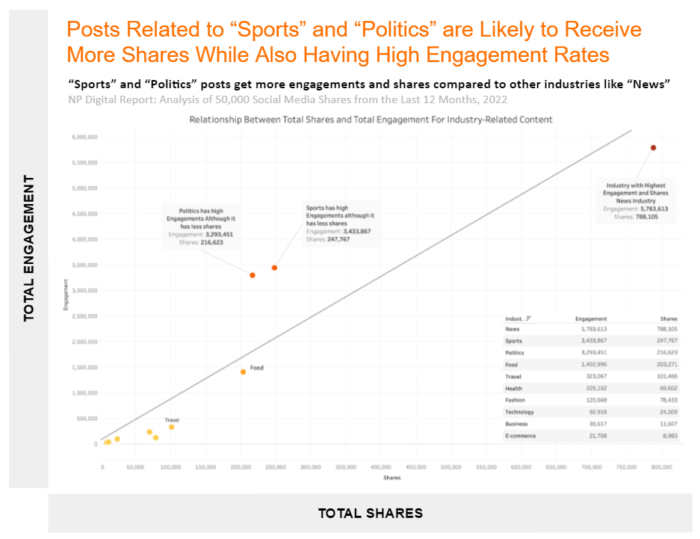
The graph above clearly shows this for each industry. If you create polarizing content, such as political content or sports-related content with a lot of diehard fans and haters, it doesn’t mean engagement alone will result in more traffic (it can but not always).
A great example of this is if I posted a piece of content on “Why the Los Angeles Lakers will win the NBA championship”. I will get tons of comments from people who support any one of the other 29 NBA teams on why I’m wrong and how their team has a better chance of winning.
Engagement on social media is great, but it can only take you so far. That is why the goal of this study is to figure out how to use social media sites to generate more organic traffic for your website and not just get “engagement”.
News clearly is the winner on both fronts if you look at the chart above. So, again, try to tie it into your content wherever possible.
Analysis #4: How Long Should Your Content Be And When Should You Share It?
For the next analysis, we thought it would be fun to look at how long your articles should be and when you should share them to get the most social traffic.
Did you know that the average article that ranks on page 1 of Google contains 1,447 words?
It used to be around 3,000 words, then in the low 2,000s and now 1,447.
With social media, we wanted to see how long content should be to generate the most shares.
Let’s first look at the average word count per industry for the 50,000 most popular articles shared.
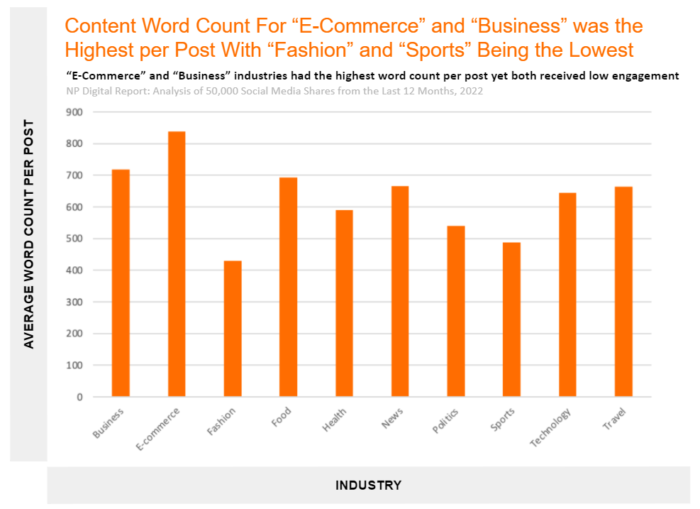
As you can see, they are short. Really short (700 words or less for most industries).
E-commerce had the highest word count, followed closely by Business. However, both of these industries had the lowest number of total engagements and total shares based on the previous charts I shared above.
Although Google may prefer long-form articles, people on social media prefer short articles over longer ones.
When you look at the articles people prefer sharing (not liking, but sharing), it is also clear that people prefer sharing shorter articles.
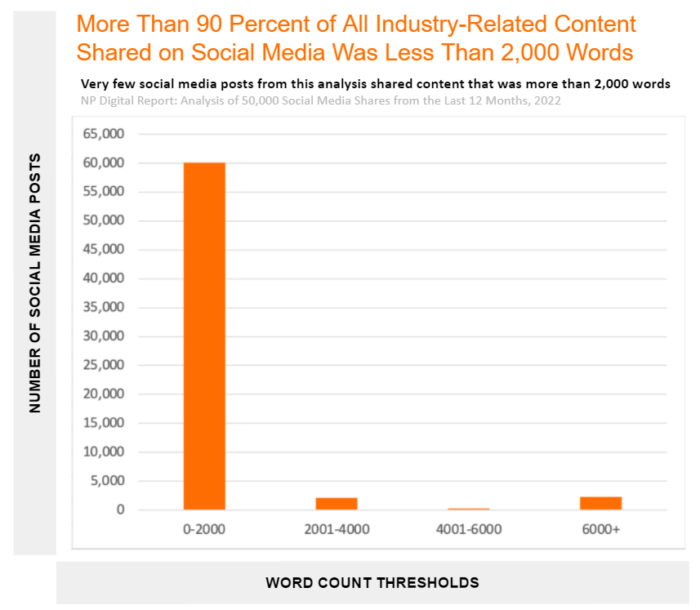
More than 90 percent of all content pieces shared on social media from this analysis were less than 2,000 words in length.
Getting someone to actively share an article is a lot rarer than simply clicking the “like” button. Keep in mind that people can share the same article over and over again.
As for when to release and promote your content, not all days are equal. It also varies per industry as well.

In general, people enjoy engaging with content most on Wednesdays followed by Thursdays and Tuesdays.
However, it isn’t that simple. Releasing content on Wednesday won’t guarantee success as it is different for each industry.
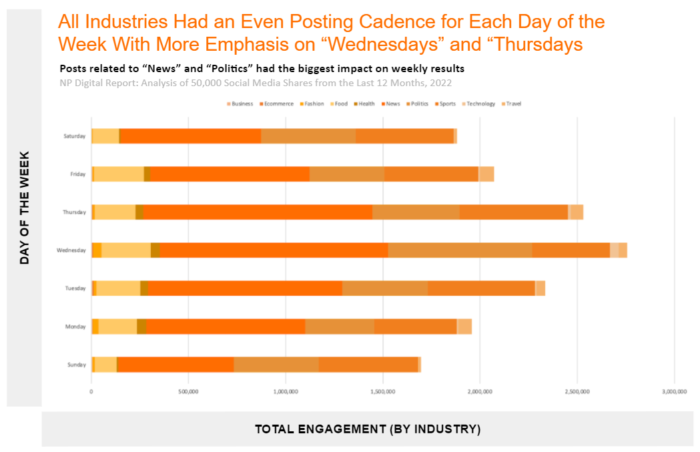
I know the graph above is hard to see as News dominates the results. So here is a version that doesn’t include News.
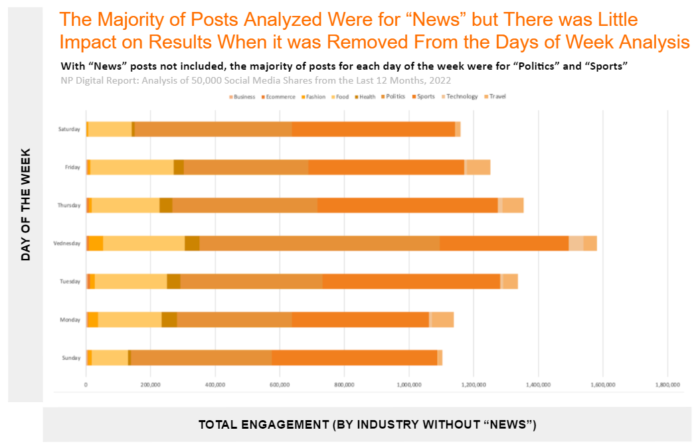
If you are in the “Food” industry you can promote your content on Wednesday but you will also do really well on Friday even though that day doesn’t work as well for other industries.
Analysis #5: Most Common Type of Facebook Reaction for Each Industry
This one was fun because we were able to pull the most popular reactions people give to posts on Facebook.
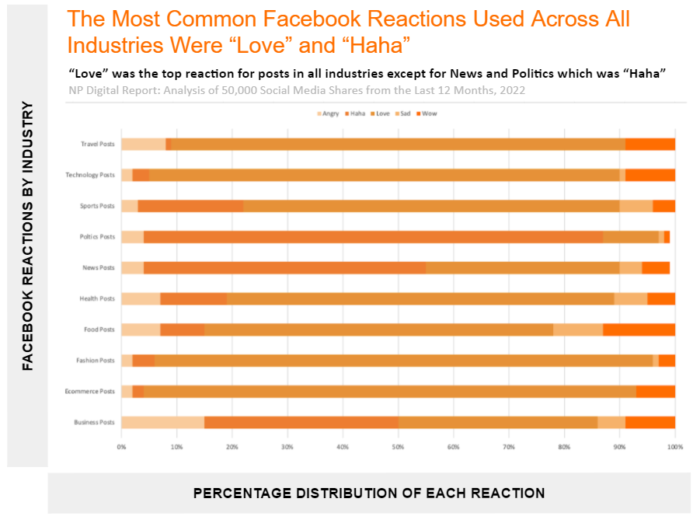
This graph shows the type of Facebook reaction (Angry, Haha, Love, Sad, Wow) that users had for posts related to each industry. Facebook reactions are the next generation of “likes” for the platform.
The key finding is that the two most popular types of reaction for all industries were either “Haha” or “Love”.
Outside of News and Politics, where the top reaction was “Haha”, “Love” was the most popular reaction for all industries.
If you want your content to do well, create content that conveys the feeling of “love” or makes people laugh. Those are the two types of reactions that people want to give the most.
Conclusion
There were a lot of interesting findings from the charts above.
The big takeaway for me was to create why-based content and write short articles if you want to do well on social media.
In general, you’ll want to:
- tie content to relevant news
- create why-based content or interview well known figures
- write shorter posts of 700 words or less to share on social media instead of 2,000+ word articles
- promote your content on Wednesday (for most industries) to get the most engagement
- create content that leverages the feeling of love or makes people laugh
Did you learn anything new from the above charts and data?
from Blog – Neil Patel https://ift.tt/E6ngzK8
via IFTTT
No comments:
Post a Comment